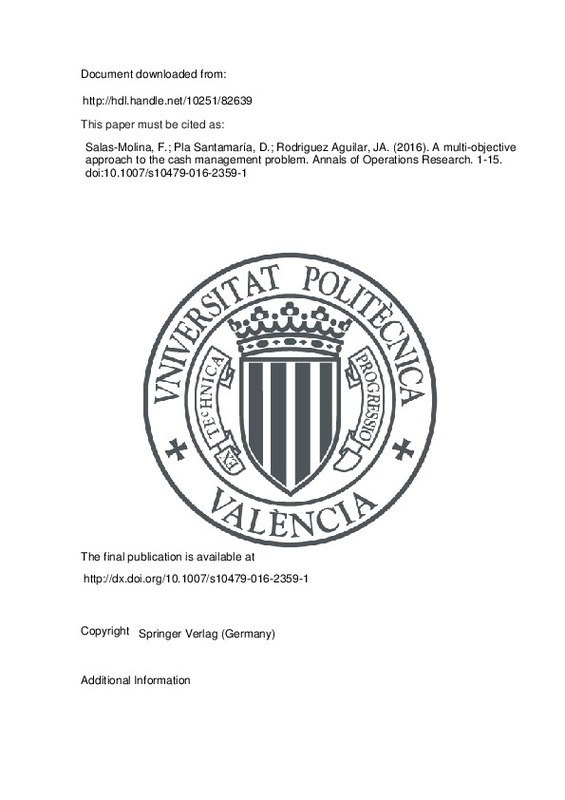Baccarin, S. (2009). Optimal impulse control for a multidimensional cash management system with generalized cost functions. European Journal of Operational Research, 196(1), 198–206.
Ballestero, E. (1998). Approximating the optimum portfolio for an investor with particular preferences. Journal of the Operational Research Society, 49(9), 998–1000.
Ballestero, E. (2005). Mean-semivariance efficient frontier: A downside risk model for portfolio selection. Applied Mathematical Finance, 12(1), 1–15.
[+]
Baccarin, S. (2009). Optimal impulse control for a multidimensional cash management system with generalized cost functions. European Journal of Operational Research, 196(1), 198–206.
Ballestero, E. (1998). Approximating the optimum portfolio for an investor with particular preferences. Journal of the Operational Research Society, 49(9), 998–1000.
Ballestero, E. (2005). Mean-semivariance efficient frontier: A downside risk model for portfolio selection. Applied Mathematical Finance, 12(1), 1–15.
Ballestero, E., & Pla-Santamaria, D. (2004). Selecting portfolios for mutual funds. Omega, 32(5), 385–394.
Ballestero, E., & Romero, C. (1998). Multiple criteria decision making and its applications to economic problems. Berlin: Springer.
Bates, T. W., Kahle, K. M., & Stulz, R. M. (2009). Why do US firms hold so much more cash than they used to? The Journal of Finance, 64(5), 1985–2021.
Baumol, W. J. (1952). The transactions demand for cash: An inventory theoretic approach. The Quarterly Journal of Economics, 66(4), 545–556.
Chen, X., & Simchi-Levi, D. (2009). A new approach for the stochastic cash balance problem with fixed costs. Probability in the Engineering and Informational Sciences, 23(04), 545–562.
Constantinides, G. M., & Richard, S. F. (1978). Existence of optimal simple policies for discounted-cost inventory and cash management in continuous time. Operations Research, 26(4), 620–636.
da Costa Moraes, M. B., & Nagano, M. S. (2014). Evolutionary models in cash management policies with multiple assets. Economic Modelling, 39, 1–7.
da Costa Moraes, M. B., Nagano, M.S., Sobreiro, V. A. (2015). Stochastic cash flow management models: A literature review since the 1980s. In P. Guarnieri (Ed.), Decision models in engineering and management. Decision engineering (pp. 11–28). Switzerland: Springer.
Eppen, G. D., & Fama, E. F. (1969). Cash balance and simple dynamic portfolio problems with proportional costs. International Economic Review, 10(2), 119–133.
Gao, H., Harford, J., & Li, K. (2013). Determinants of corporate cash policy: Insights from private firms. Journal of Financial Economics, 109(3), 623–639.
Girgis, N. M. (1968). Optimal cash balance levels. Management Science, 15(3), 130–140.
Gormley, F. M., & Meade, N. (2007). The utility of cash flow forecasts in the management of corporate cash balances. European Journal of Operational Research, 182(2), 923–935.
Gregory, G. (1976). Cash flow models: A review. Omega, 4(6), 643–656.
Markowitz, H. (1952). Portfolio Selection. The Journal of Finance, 7(1), 77–91.
McNeil, A. J., Frey, R., & Embrechts, P. (2005). Quantitative risk management: Concepts, techniques and tools. Princeton: Princeton University Press.
Melo, M. A., & Bilich, F. (2013). Expectancy balance model for cash flow. Journal of Economics and Finance, 37(2), 240–252.
Miller, M. H., & Orr, D. (1966). A model of the demand for money by firms. The Quarterly Journal of Economics, 80(3), 413–435.
Myers, S. C., & Brealey, R. A. (2003). Principles of corporate finance (7th ed.). NewYork: McGraw-Hill.
Neave, E. H. (1970). The stochastic cash balance problem with fixed costs for increases and decreases. Management Science, 16(7), 472–490.
Penttinen, M. J. (1991). Myopic and stationary solutions for stochastic cash balance problems. European Journal of Operational Research, 52(2), 155–166.
Pinkowitz, L., Stulz, R. M., & Williamson, R. (2016). Do US firms hold more cash than foreign firms do? Review of Financial Studies, 29(2), 309–348.
Pla-Santamaria, D., & Bravo, M. (2013). Portfolio optimization based on downside risk: A mean-semivariance efficient frontier from dow jones blue chips. Annals of Operations Research, 205(1), 189–201.
Premachandra, I. (2004). A diffusion approximation model for managing cash in firms: An alternative approach to the Miller–Orr model. European Journal of Operational Research, 157(1), 218–226.
Roijers, D. M., Vamplew, P., Whiteson, S., & Dazeley, R. (2013). A survey of multi-objective sequential decision-making. Journal of Artificial Intelligence Research, 48(1), 67–113.
Ross, S. A., Westerfield, R., & Jordan, B. D. (2002). Fundamentals of corporate finance (6th ed.). NewYork: McGraw-Hill.
Sharpe, W. F. (1966). Mutual fund performance. The Journal of Business, 39(1), 119–138.
Sharpe, W. F. (1994). The sharpe ratio. The Journal of Portfolio Management, 21(1), 49–58.
Srinivasan, V., & Kim, Y. H. (1986). Deterministic cash flow management: State of the art and research directions. Omega, 14(2), 145–166.
Steuer, R. E., Qi, Y., & Hirschberger, M. (2007). Suitable-portfolio investors, nondominated frontier sensitivity, and the effect of multiple objectives on standard portfolio selection. Annals of Operations Research, 152(1), 297–317.
Stone, B. K. (1972). The use of forecasts and smoothing in control-limit models for cash management. Financial Management, 1(1), 72–84.
Whalen, E. L. (1966). A rationalization of the precautionary demand for cash. The Quarterly Journal of Economics, 80(2), 314–324.
Yu, P. L. (2013). Multiple-criteria decision making: Concepts, techniques, and extensions. Berlin: Springer.
Zeleny, M. (1982). Multiple criteria decision making. NewYork: McGraw-Hill.
Zopounidis, C. (1999). Multicriteria decision aid in financial management. European Journal of Operational Research, 119(2), 404–415.
[-]







![[Cerrado]](/themes/UPV/images/candado.png)


